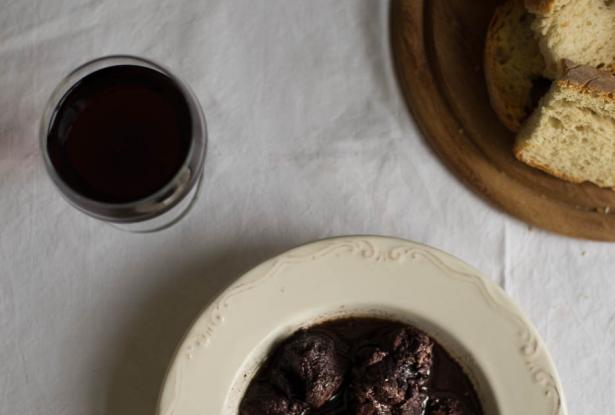Peposo alla Fornacina (Florentine Beef and Pepper Stew)

The year was 1418. Florence's elders were convening to address a pressing issue that had been neglected for years: an enormous hole in the roof of Santa Maria del Fiore. In 1296, construction had begun on the cathedral that was supposed to flaunt Florence's newfound status as one of Europe's most important economic centres. Instead, year after year, the high altar of a city enrichened by the silk and wool trades was subject to the whims of mother nature: downpours in the colder months and the scorching heat in summer. Rejecting the Gothic flying buttresses and pointed arches of their northern Italian city-state rivals like Milan, the elders announced a contest for designing what would then be the largest cupola or dome on earth.
Leading architects from near, far and wide flocked to Florence for their shot at fame and the chance to win the coveted sum of 200 florins. The ideal proposal would not include a central pillar to hold up the dome, despite many an architect insisting that this was the only way. A homely and hot-tempered goldsmith's solution to this architectural conundrum soon captured the project's overseers' imagination. Filippo Brunelleschi, reputed for being both a buffoon and a genius, said he would build two domes, one inside supporting the outer cupola and with no scaffolding.
By 1420, Brunelleschi had managed to convince the overseers of the brilliance of his scheme and was made provveditore or superintendent of the cupola project. When building commenced later that year, the amateur architect more than proved his worth by inventing a series of lifting mechanisms which were capable of raising even the heaviest building materials up to 180 feet above ground.
One of those building materials was a type of terracotta famous for its vibrant red colour and resistance to frost made in the nearby hilltop town of Impruneta. A true perfectionist, Brunelleschi made a point of visiting Impruneta to personally supervise the production of the tiles that would eventually grace the exterior of the cathedral's outer cupola. The fornacini or kiln workers laboured long hours to get the results Brunelleschi wanted. During the second and final firing of the tiles, the provveditore noticed that the workers would often put a large pot inside the kiln close to its opening. Later on, they would then help themselves to the stew simmering gently inside after leaving it to cook for much of the day.
The dish the workers prepared for themselves while firing the terracotta tiles was what Florentines today refer to as peposo alla fornacina. Made by cooking diced beef in red wine and aromatised with a generous amount of peppercorns, Brunelleschi, according to local legend, is said to have fallen in love with the dish on his visits to Impruneta.
These days, you'll find many variations on this recipe for peposo which include herbs, diced root vegetables and tomato passata or puree. Purists, however, are quick to point out that the Americas (and, thus the tomato) had yet to be discovered in Brunelleschi's time. And, after trying the Tuscan-based food writers Emiko Davies' and Giulia Scarpaleggia's essential, pared-down interpretations (the recipe below is based on elements from their respective ones) of this dish, it's hard to disagree with them. Made with just six ingredients – marbled beef, olive oil, wine, garlic, salt, pepper – it is one of the tenderest and heartwarming beef stews I've ever tasted.
A few notes on making and serving this stew. The pepper, although it sounds like a unusually large amount, is mellowed by the long simmer in the red wine. Don't care for biting into the 'black gold' that once sent the Roman coffers broke? Don't worry, neither do I. The solution? Collect the throat-tingling peppercorns in a piece of cotton gauze and remove the sachet from your casserole once it's time to serve. Ah yes, serving. Like many pot roasts and stews, you'll probably find the flavours of your peposo are enhanced by several hours of rest after cooking. So, make this in advance, reheat it gently and you'll be rewarded with an even more aromatic stew come dinnertime.
Ingredients (serves 4)


Heat olive oil in a heavy-bottomed casserole or stockpot. Brown the diced meat ion medium heat. When the meat is browned all over, add the peeled garlic cloves, peppercorn sachet and red wine. Bring to boil, then lower heat to a gentler simmer. Cook covered for 2 hours. Remove lid, add salt and cook on low-medium heat for another 45 minutes to 1 hour, to reduce cooking liquid. Taste, and add more salt if necessary.
Remove sachet and serve with plenty of unsalted Tuscan bread to mop up the wine and pepper-infused sauce. Buon appetito!





